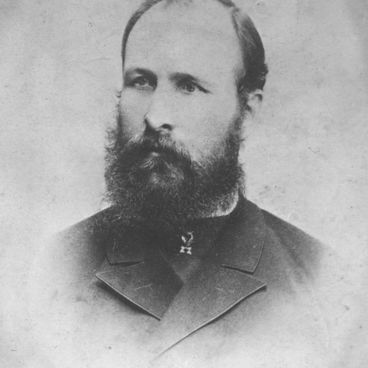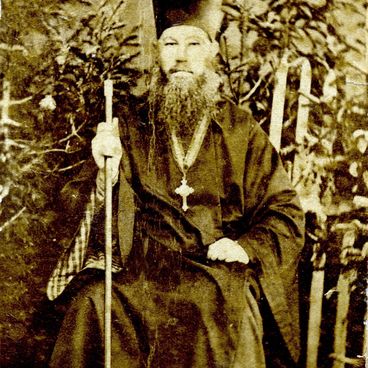The early 20th century photograph shows one of the best-known merchants and entrepreneurs of Kuznetsk, Alexey Fonaryov.
Practically nothing is known about Fonaryov’s life before his move to Kuznetsk. According to his contemporaries, Fonaryov arrived in the city “wearing bast shoes” and was virtually penniless. He presented a document that stated that he was a petty bourgeois from the city of Kovrov, the Vladimir Governorate, and the local municipal government accepted the document. However, historians failed to find any records on Fonaryov in city archives of Kovrov, not even a single reference of his name.
The first written evidence of his activity on the soil of Kuznetsk is dated 1894: “Alexey Egorov Fonaryov, having a family, is engaged in retail trade in the village of Kuzedeyevo, lives a sober lifestyle, has no criminal background; according to private rumors, he is involved in buying marauding gold from non-Russians and gold-extraction workers, and, living among non-Russians, he exploits them buying honey, wax and furs, at that, he is extremely cautious and difficult to catch”.
Those days it was impossible to get to Kuzedeyevo bypassing Kuznetsk. Therefore, historians believe that originally, in 1890-1990s, Fonaryov settled down in the city, and only a few years later he started to carry out barter trade with Shoriyan villages. That strategy ensured the merchant’s financial success.
Soon he bought a house in an elite neighborhood of Kuznetsk and opened his shop there [1], that became one of the best in town. Fonaryov extensively traded most various goods: from foodstuffs to exquisite jewelry. His shop was located at the intersection of two large streets, therefore there were always plenty of shoppers there. However, his high-quality goods attracted not only shoppers: according to his contemporaries, more than once Fonaryov’s shop became a target for robbers.
After the October revolution the merchant’s mansion was nationalized. In various years it used to house a jail, apartments for local functionaries, an orphanage, a college, an office of a utility provider and other institutions. Now the building houses a branch of the Kuznetsk Fortress Museum Reserve.
Practically nothing is known about Fonaryov’s life before his move to Kuznetsk. According to his contemporaries, Fonaryov arrived in the city “wearing bast shoes” and was virtually penniless. He presented a document that stated that he was a petty bourgeois from the city of Kovrov, the Vladimir Governorate, and the local municipal government accepted the document. However, historians failed to find any records on Fonaryov in city archives of Kovrov, not even a single reference of his name.
The first written evidence of his activity on the soil of Kuznetsk is dated 1894: “Alexey Egorov Fonaryov, having a family, is engaged in retail trade in the village of Kuzedeyevo, lives a sober lifestyle, has no criminal background; according to private rumors, he is involved in buying marauding gold from non-Russians and gold-extraction workers, and, living among non-Russians, he exploits them buying honey, wax and furs, at that, he is extremely cautious and difficult to catch”.
Those days it was impossible to get to Kuzedeyevo bypassing Kuznetsk. Therefore, historians believe that originally, in 1890-1990s, Fonaryov settled down in the city, and only a few years later he started to carry out barter trade with Shoriyan villages. That strategy ensured the merchant’s financial success.
Soon he bought a house in an elite neighborhood of Kuznetsk and opened his shop there [1], that became one of the best in town. Fonaryov extensively traded most various goods: from foodstuffs to exquisite jewelry. His shop was located at the intersection of two large streets, therefore there were always plenty of shoppers there. However, his high-quality goods attracted not only shoppers: according to his contemporaries, more than once Fonaryov’s shop became a target for robbers.
After the October revolution the merchant’s mansion was nationalized. In various years it used to house a jail, apartments for local functionaries, an orphanage, a college, an office of a utility provider and other institutions. Now the building houses a branch of the Kuznetsk Fortress Museum Reserve.


